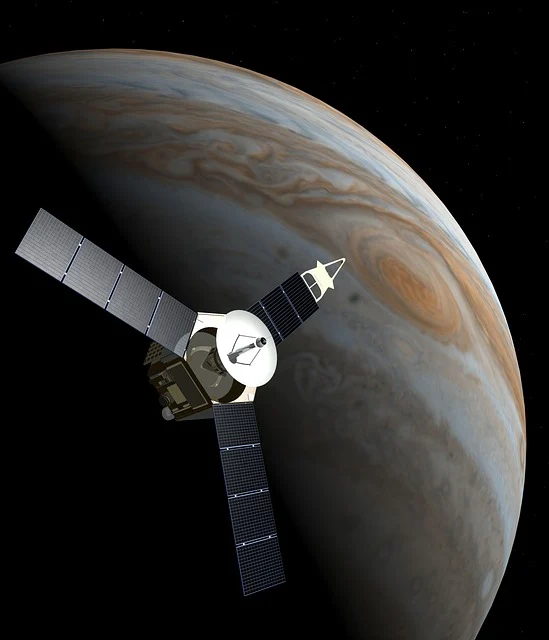Gravitational potential energy (GPE), particularly in mechanics, which describes how things interact in a gravitation in a field. The energy that an object possesses as a result of its location within a gravitational field is known as gravitational potential energy. It is directly correlated with the mass and height of the objects, as well as the gravitational force’s intensity.

The gravitational potential energy of a body at a point in a gravitational field of another body is defined as the amount of work done in bringing the given body from the infinity to that point. The gravitational potential energy between two bodies of mass M and m separated by a distance r is given by: U = GMm / r where U is taken to be zero as r .
Gravitational potential energy is a scalar quantity. Its dimensional formula is [ML2T-2] and SI unit is J. Gravitational potential energy of a body of mass m at height h above the surface of the Earth is given by
Uh = -GMEm / (RE + h). Gravitational potential energy of a body of mass m on the surface of the Earth is given by:
Us = -GMEm / RE

What is Gravitational Potential Energy?
Gravitational potential energy is the energy held in an object because of its height above a reference point, usually the ground or some other zero-energy level. A book is given gravitational potential energy, e.g, when we pick it up from a table and hold it in the air. The effort you put forth to lift the book against gravity is what gives we this energy.
Formula for Gravitational Potential Energy
The mathematical expression for gravitational potential energy is:
U = mgh Where:
U = Gravitational potential energy (in joules)
m = Mass of the object (in kilograms)
g = Acceleration due to gravity (approximately 9.8 m/s2 on Earth)
h = Height of the object above the reference point (in meters)
According to this equation, an object’s gravitational potential energy rises with its mass, height, and the gravitational pull of a planet or other celestial body.

The Components
1.Mass (m): Because it takes more force to lift heavier things against gravity, they have a higher gravitational potential energy.
2. Height (h): An object’s gravitational potential energy increases with altitude.
3. Gravitational Acceleration (g): The celestial body has an impact on this. For example, an object would have less gravitational potential energy at the same height on the Moon since gravity is weaker there than it is on Earth.
Examples of Gravitational Potential Energy
1. A Pendulum: A pendulum’s gravitational potential energy is greatest at the top of its swing. This energy changes into kinetic energy as it swings downward.
2. Water in a Dam: Gravitational potential energy is present in water that is stored at a height in a dam. This energy is transformed into kinetic energy and discharged to produce electricity.
3. A roller coaster: The roller coaster’s gravitational potential energy is at its highest at the top of a hill, and as it drops, it transforms into kinetic energy.

Work Done and Gravitational Potential Energy
Work is done when we lift anything against gravity. This effort is stored as gravitational potential energy within the object. For example, the following work is completed if we raise a 10-kg box to a height of two meters: W = mgh = 10 × 9.8 × 2 = 196 joules
This work is now stored as the gravitational potential energy of the box.
Key Points to Remember
We are performing work when we raise something against gravity. The object retains this effort as gravitational potential energy. When a box weighing 10 kg is raised to a height of 2 meters, for example, the following work is completed: W = mgh = 10 × 9.8 × 2 = 196 joules.
Real-World Applications
• Engineering: To design structures like bridges, dams, and elevators is made easier with an understanding of gravitational potential energy.
Astronomy: When we determining escape velocity and orbital dynamics for space missions, gravitational potential energy is a vital component.
Renewable Energy: Hydroelectric power plants produce electricity by harnessing the gravitational potential energy of stored water.
Note:
The relationship between forces and motion in a gravitational field requires an understanding of gravitational potential energy. We can address energy transfer problems, forecast object behavior, and create useful engineering and technological systems by evaluating GPE.
The energy that an object has because of its location within a gravitational field is known as gravitational potential energy. The gravitational acceleration, height above a reference point, and mass of the item all affect it. The formula is U = mgh, where m represents mass, g is gravity-induced acceleration, and h is height.
The formula for gravitational potential energy is:
U = mgh Where:
U is the gravitational potential energy (in joules),
m is the object’s mass (in kilograms),
g is the gravitational acceleration (9.8 m/s2 on Earth),
h is the height above the reference point (in meters).
Gravitational potential energy depends on:
Mass (m): Heavier objects have more GPE.
Height (h): The object kept at higher place, the greater its GPE.
Gravitational acceleration (g): GPE is higher on planets with stronger gravitational forces.
Gravitational Potential Energy is the energy stored in an object due to its height and position in a gravitational field. The formula for gravitational potential energy is: U = mgh
Kinetic Energy is the energy of an object possesses due to its motion, given by KE = 1 / 2 mv2.
These two types of energy often transform into each other in systems like a swinging pendulum or a falling object.
The gravitational potential energy is regarded as 0 at the reference location. This point is relative to the GPE value. For example, in difficulties, the ground is frequently selected as the reference point; however, depending on the circumstances, any other point may be employed.
Yes, negative gravitational potential energy is possible. When the item is below the selected reference point, this occurs. For example, an object in a hole will have a negative height (h) and a negative GPE if the ground is the reference point.
Gravitational potential energy is used in various real-world contexts, such as:
Hydroelectric power plants: Converting GPE of water stored in dams into electricity.
Roller coasters: Using GPE at the peak of hills to power motion.
Space exploration: Calculating energy required to launch spacecraft.
Everyday activities: Understanding energy transfers when lifting or dropping objects